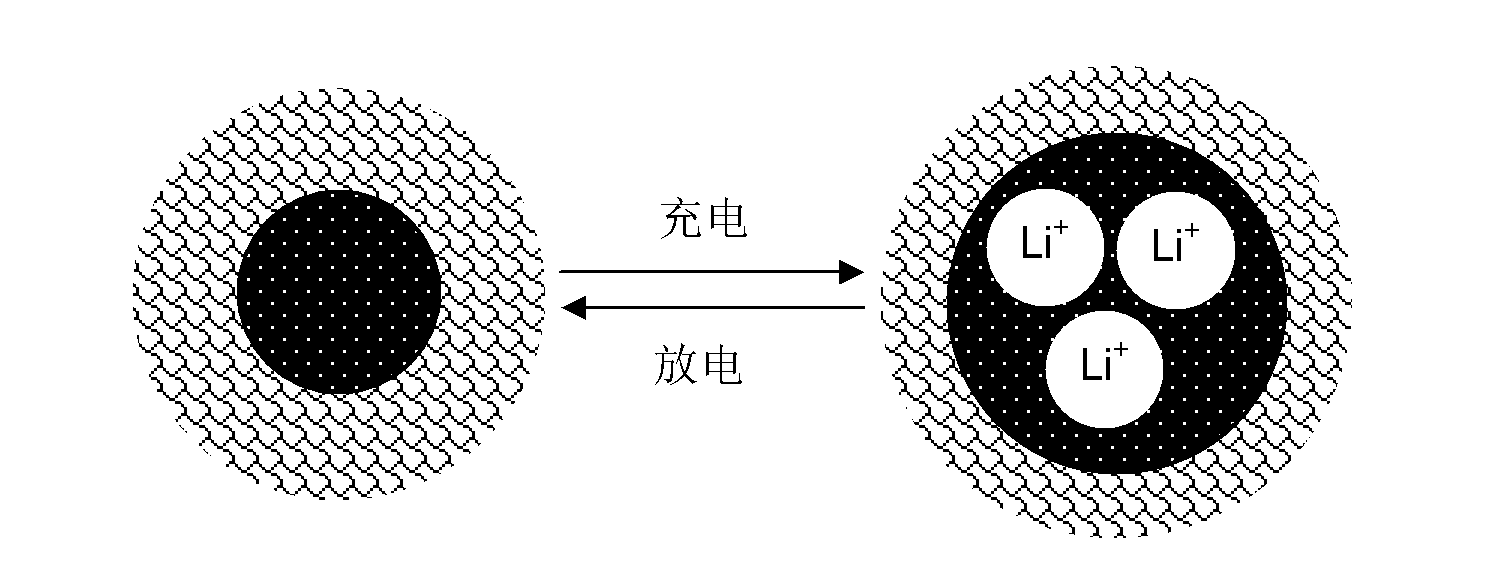Anode material used for lithium ion battery and preparation methods thereof
A technology for lithium-ion batteries and negative electrode materials, applied to battery electrodes, circuits, electrical components, etc., can solve problems such as weak binding force, reduced battery life, carbon layer separation, and peeling
- Summary
- Abstract
- Description
- Claims
- Application Information
AI Technical Summary
Problems solved by technology
Method used
Image
Examples
Embodiment 1
[0034] (1) dissolving the organic precursor polyacrylonitrile in tetrahydrofuran to form a homogeneous solution with a mass concentration of 10%;
[0035] (2) adding a certain amount of silicon into the above solution, and mixing the silicon with the solution evenly to form a spinning stock solution; the amount of silicon added is 5wt.% of the organic precursor;
[0036] (3) Prepare the organic fiber felt containing silicon by the above spinning stock solution by electrospinning; wherein the spinning stock solution propulsion speed is 1mL / h, the voltage is 15KV, and the receiving distance is 10cm;
[0037] (4) Carbonize the organic fiber felt in an argon atmosphere, and heat up at a heating rate of 10°C / min until the temperature of the furnace body is 900°C; after 4 hours of heat preservation, all the organic fibers are pyrolyzed and carbonized to form carbon fibers ;
[0038] (5) Pulverize the material obtained in the previous step to obtain the anode material for lithium-io...
Embodiment 2
[0042] (1) dissolving the organic precursor polyacrylonitrile in dimethyl sulfoxide to form a homogeneous solution with a mass concentration of 30%;
[0043] (2) adding a certain amount of silicon monoxide into the above solution, and mixing the silicon monoxide with the solution evenly to form a spinning stock solution; the amount of silicon monoxide added is 5wt.% of the organic precursor;
[0044] (3) Prepare the organic fiber mat containing silicon monoxide by electrospinning the above spinning stock solution; wherein the spinning stock solution advance speed is 1.5mL / h, the voltage is 25KV, and the receiving distance is 15cm;
[0045] (4) Carbonize the organic fiber mat in a mixed gas of 5% hydrogen and 95% argon, and heat up at a heating rate of 5°C / min until the temperature of the furnace body is 900°C; All organic fibers are pyrolyzed and carbonized to form carbon fibers;
[0046] (5) Pulverizing the material obtained in the previous step to obtain the anode material ...
Embodiment 3
[0050] (1) dissolving the organic precursor polyacrylonitrile in dimethylamide to form a homogeneous solution with a mass concentration of 15%;
[0051] (2) adding a certain amount of silicon dioxide to the above solution, and mixing the silicon dioxide with the solution evenly to form a spinning stock solution; the amount of silicon dioxide added is 10wt.% of the organic precursor;
[0052] (3) Prepare the organic fiber felt containing silicon dioxide by electrospinning the above spinning stock solution; wherein the spinning stock solution propulsion speed is 1.2mL / h, the voltage is 18KV, and the receiving distance is 11.5cm;
[0053] (4) Carbonize the organic fiber mat in an argon atmosphere, and heat up at a heating rate of 5°C until the temperature of the furnace body is 800°C; after 4 hours of heat preservation, all the organic fibers are pyrolyzed and carbonized to form carbon fibers;
[0054] (5) Pulverizing the material obtained in the previous step to obtain the anode...
PUM
| Property | Measurement | Unit |
|---|---|---|
| diameter | aaaaa | aaaaa |
Abstract
Description
Claims
Application Information
 Login to View More
Login to View More - R&D
- Intellectual Property
- Life Sciences
- Materials
- Tech Scout
- Unparalleled Data Quality
- Higher Quality Content
- 60% Fewer Hallucinations
Browse by: Latest US Patents, China's latest patents, Technical Efficacy Thesaurus, Application Domain, Technology Topic, Popular Technical Reports.
© 2025 PatSnap. All rights reserved.Legal|Privacy policy|Modern Slavery Act Transparency Statement|Sitemap|About US| Contact US: help@patsnap.com



